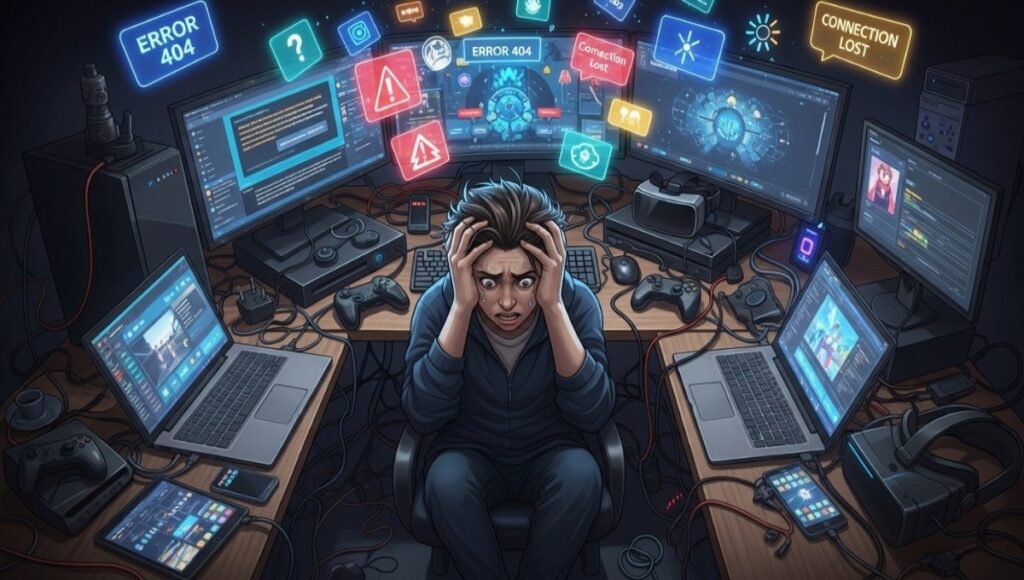
Technology is supposed to make life easier, right? Yet, sometimes it feels like modern gadgets exist solely to test our patience. From cryptic software prompts to poorly designed hardware, tech can be more irritating than helpful. Today, we’re diving deep into the common tech frustrations that drive users crazy and how small design oversights turn everyday tasks into a battle of wits.
Endless Prompts and Confusing Software
One of the most frequent annoyances is being bombarded with prompts while signing into software or apps. For example, many users encounter repeated messages asking whether to allow organizational control or system-wide sign-ins. While these may be intended for security, the lack of a simple “don’t ask me again” option turns them into a daily headache. This is one of the top common tech frustrations because it interrupts workflow and makes even basic tasks feel like a chore.
Similarly, apps like cloud storage can blur the line between syncing and backing up. Many users assume their files are safely backed up, only to realize that deletion from the cloud removes them everywhere. Clear communication about what’s actually happening is missing, making it another classic tech gripe.
Hardware Hassles That Shouldn’t Exist
PC enthusiasts know the pain of toolless hardware claims that aren’t really toolless. Removing GPUs, CPU coolers, or even SSDs often requires awkward tools, risking damage to your components. PCIe locks and heat sinks might look sleek, but they can make maintenance unnecessarily stressful. Even something as simple as a case window or cable management becomes a design puzzle, frustrating users who simply want an easy, functional setup.
Peripheral devices aren’t innocent either. Gaming consoles, docking stations, and HDMI connections often introduce more trouble than convenience. Confusing power requirements, compatibility issues with third-party accessories, and inconsistent performance turn what should be a fun experience into a constant test of patience. These are some of the most maddening common tech frustrations that gamers and tech enthusiasts face daily.
Software Interfaces That Don’t Understand Users
User interfaces for apps and devices are another pain point. Slow search functions, poorly designed scrollbars, and cryptic menus make navigation cumbersome. Platforms that once provided free, seamless communication now push subscriptions, add-ons, and paid features, which can feel like exploitation rather than enhancement. Even after multiple updates, users often find the same bugs or missing features persist, which adds to frustration.
Discord, for instance, was once a favorite for gamers and communities but now faces criticism for poor UX, constant upselling, and inefficient knowledge management. When software doesn’t prioritize user experience, small daily tasks turn into major headaches, proving that common tech frustrations aren’t limited to hardware—they’re equally software-based.
Backup and File Management Nightmares
Another widespread source of irritation is file backup. Many assume cloud syncing equals safe backup, but accidental deletions or misconfigured sync folders can lead to data loss. True backups—cloning drives or creating system images—are either hidden behind deprecated tools or require third-party software. Users need clear, reliable options for protecting their data without guessing whether their files are truly safe.
Why These Frustrations Matter
While some tech annoyances might seem trivial, they add up, creating stress and wasting time. Whether it’s confusing software prompts, overly complicated hardware, or poorly designed interfaces, these frustrations highlight the gap between user expectations and actual experience. Addressing these issues doesn’t require radical innovation—just thoughtful, user-centric design.
Final Thoughts
Everyone loves technology, but even the most patient users have limits. Recognizing common tech frustrations and understanding their root causes can help users make better choices about hardware, software, and workflow. More importantly, it reminds tech companies that usability should never take a backseat to marketing or aesthetics.